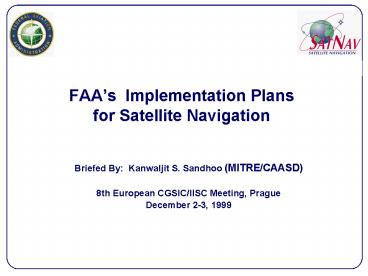FAAs Implementation Plans for Satellite Navigation - PowerPoint PPT Presentation
1 / 16
Title:
FAAs Implementation Plans for Satellite Navigation
Description:
Absence of Instrument Approaches at Qualified Runways ... Software Final Qualification Test Completed. 7 of 8 Design Qualification Tests Completed ... – PowerPoint PPT presentation
Number of Views:31
Avg rating:3.0/5.0
Title: FAAs Implementation Plans for Satellite Navigation
1
FAAs Implementation Plansfor Satellite
Navigation
Briefed By Kanwaljit S. Sandhoo
(MITRE/CAASD) 8th European CGSIC/IISC Meeting,
Prague December 2-3, 1999
2
Overview
- Background
- SATNAV Program Objectives
- Wide Area Augmentation System (WAAS)
- Local Area Augmentation System (LAAS)
- Summary
3
Basic GPS Civil Aviation Benefits
- Improves Aviation System Safety
- Available for Primary Use in the Oceanic Phase of
Flight - Available for Supplemental Use for En Route,
Terminal, and Non-Precision Phases of Flight - Cost Effective Resource for Nations with Limited
Air Navigation Infrastructures - Primary Means Use of GPS can Reduce or Eliminate
Maintenance Costs Associated with Older Expensive
Ground-based Navigation Aids
4
Current Navigation Deficiencies
- Large Separation Standard Requirements
- Lack of accurate Aircraft Position/Navigation
Data - Inability to Provide Optimum Routings to all
Users - Absence of Instrument Approaches at Qualified
Runways - Restrictive Departure Procedures in Poor
Visibility - Limited Automated Aircraft Surface Navigation
5
Basic GPS System Limitations
- Integrity
- Notification Time 15 Minutes or Greater
- Availability
- 70 for 24 satellites
- 98 for 21 satellites
- Accuracy
- Sufficient for En Route through Non-Precision
Approach - Not Sufficient for Precision Approach
Does not satisfy Civil Aviation Requirements for
Primary-means Navigation in all Phases of Flight
6
Satellite Navigation Program Objective
7
Wide Area Augmentation System (WAAS)
- Safer
- Increased Capacity
- Cost Effective
8
WAAS Phase I Status
- Hardware Installed and Tested
- 25 WAAS Reference Stations (WRS)
- 2 WAAS Master Stations (WMS)
- Communications Installed and Operational
- 2 INMARSAT Satellites (AOR-W and POR)
- Terrestrial Communications Network
- Software
- Software Final Qualification Test Completed
- 7 of 8 Design Qualification Tests Completed
- Successfully Completed 3 Signal in Space Builds
- System Integration Completed
9
WAAS Phase I Capabilities
- Introduces Operational Capability
- Non-Precision Approach
- Precision approach WAAS Precision Approach
procedures and GPS/WAAS Certified Receivers Will
Become Available to the Aviation Community - Increases Quantity of Airfields with Precision
approach Capability
10
WAAS Phase ISchedule
- 60 Day Stability Test/DQT 1/30/00
- Contractor Acceptance Inspection 4/25/00
- Joint Resource Council In Service Review (ISR)
Decision 6/30/00 - Instrument Approaches Published 9/07/00
- Commissioning (IOC) 9/25/00
11
WAAS FOCInvestment Analysis
- Scope
- Congress Wants SatNav Program to be Most
Cost-Beneficial - Congress Wants FAA to Conduct Lease vs. Buy of
WAAS Satellites - FAA Needs to Re-Baseline WAAS and LAAS Programs
- Approach
- Involve Users, Industry, and Government Agencies
- Re-Calculate Benefits/Costs Using Conservative
Approach - Focus on Risk Reduction Strategies in Determining
Recommendations
12
WAAS FOCInvestment Analysis (Contd)
- Four Alternatives Developed and Analyzed
Includes Different Levels of Investment in
WAAS/LAAS/Navaids - Preferred Alternative Based on Performance,
Benefit/Cost (2.4), Risks, and Strategic
Considerations - Checkpoints Built to Minimize Risk and Allow
Alternate Paths - Navaids Reduced 2008-2013 to Basic Backup Network
- 4 GEO Satellites to be Acquired Between 2002 and
2008 - Precision Approach Throughout CONUS
- Capable of Being the Only Navigation System in an
Aircraft - Final Operating Capability (FOC) FY2006
- Capable of Being the Only Navigation Service
Provided by the FAA
13
Local Area Augmentation System (LAAS)
L1 - 1575.42 MHz
14
LAASAcquisition Schedule
99 01 03 05 07 09 11
Assumed by FAA for Maintenance/Liability
18
CAT I Part 171
20 20 20 7 7 8 8
8 8
CAT I Acquisition
(Total of 124 CAT I)
CAT III FSD
RD
CAT III Conversion from CAT I
(Converts78 CAT I to CAT III)
26 26 26
CAT III New Procurement
12 12 12
(Total 0f 114 CAT III)
SUMMARY 160 Total LAAS - 46 CAT I -
114 CAT III (78 CAT I Conversion 36 New
Procurement)
15
Summary
- On September 2, 1999, the FAA JRC Reinforced the
FAAs Commitment to Satellite-Based Navigation - WAAS and LAAS Baseline Approved
- Low-End Users Get Safety and Access
- High-End Users Get
- Improved Safety
- More Airports and Runways
- More Efficiencies in Airspace and Terminal Areas
- FAA Gets Modernization of NAS
- Improved Safety, Improved Efficiency, and Reduced
Cost
16
FAA GPS Product TeamWebsite
- For further information on the FAAs WAAS
Program, please visit our website at - http//gps.faa.gov































